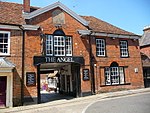The Angel Inn is a public house in Andover, Hampshire. Constructed in the mid-15th century, it is one of England's oldest surviving inns, and the oldest and most complete example in Hampshire. It is a Grade II* listed building, of "more than special interest nationally." Despite alterations in the 16th, 17th, 18th and 19th centuries, the medieval timber frame, features and decorative details remain "remarkably intact." Archaeological and documentary evidence suggest that it was built on the site of a previous inn—the College Inn—which was destroyed in the Great Fire of Andover in 1434.Originally constructed of four wings enclosing a central courtyard, with an archway giving access from the street—typical of late medieval inns—the pub now retains the north and east wings. The west wing is no longer extant, while the surviving section of the south wing—which was divided from the inn for other commercial uses in the 18th century—is now also Grade II* listed (under the designation "89, 91 & 93 High Street, Andover.") The main bar room is situated in the ground floor of the north wing, which housed stables during the medieval period. The 'front bar' occupies the ground floor room—originally a high status guest chamber—at the eastern end of the north wing, looking onto the High Street. During the early 19th century, the front bar also served as the town's magistrates' court and guildhall.In the 1960s, Andover became an overspill town for London, resulting in redevelopment of the town centre and the construction of a large shopping centre. The Angel Inn—along with other late medieval parts of the town—was initially earmarked for demolition in 1965 as part of the redevelopment, but was saved following a campaign by members of the public.The Angel Inn is Cask Marque accredited and listed by CAMRA—the Campaign for Real Ale—as one of the best cask ale pubs in the UK.








